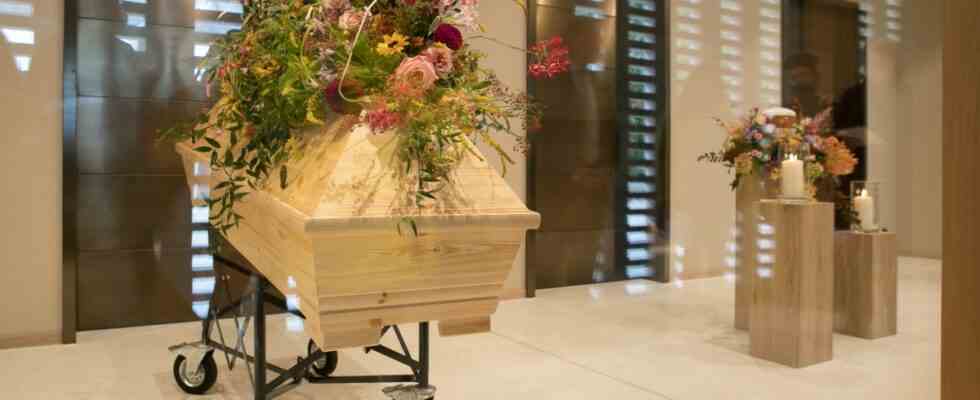In December 1908, after years of struggle, the Munich Cremation Association reached its goal. The city magistrate has provided him with an incinerator for coffin boards and funeral wreaths in the service yard of the eastern cemetery – for an annual lease of 200 gold marks. As a result, the association, founded in 1891, converted the facility into a cremation furnace. And so the first cremation in Munich can take place there in November 1912.
Since then, dealing with the dead has not only experienced a profound change in Munich. Today, 70 percent of all bodies are cremated there – and the trend has been rising for years. Against this background, the city has now opened a new crematorium in the Ostfriedhof. In the triangular building, which adjoins the listed mourning hall, the rooms for farewell, laying out and cremation are under one roof. This enables a “farewell from a single source”, as Mayor Verena Dietl (SPD) put it at the opening ceremony. The new crematorium replaces the 40-year-old previous building. This was a “purely technical building”, said the municipal health officer Beatrix Zurek. “People are the focus of the new crematorium.”
Long awaited: the new crematorium in the Ostfriedhof.
(Photo: Florian Peljak)
View of the oven hall: Thomas Schlichting, Head of Pastoral Care and Church Life in the Archbishop’s Ordinariate, can watch the coffin drive in.
(Photo: Florian Peljak)
For the first time, mourners can say goodbye directly to the coffin – in a separate room for up to 24 hours. “We have a high demand in this area, which will increase in the future,” said the head of the crematorium, Arndt Schulte Döinghaus. The same applies – not least as a result of the pandemic – to the live streaming of funeral services, which is possible in the new farewell room. From there the corpse is laid out before it is cremated. Mourners can follow this in the new building – behind a pane of glass from an adjoining room. Such accompaniment of the coffin entrance is unique in Germany in crematoria, says Schulte Döinghaus. “There are mourners who don’t want it because it’s too close for them. But overall, this option is being asked for more and more frequently.” Of course, so much service has its price: A cremation costs from 2,500 to up to 9,000 euros, says the manager. With coffin burials, you have to reckon with about twice as much.
According to Schulte Döinghaus, the aim of the new crematorium is to enable the entire farewell ceremony, from the funeral service to the urn burial, to be carried out in one day – this is also a wish of many mourners. They should soon be able to hold the funeral feast in the immediate vicinity. The Archdiocese of Munich and Freising is building the “Haus am Ostfriedhof” funeral pastoral center right next to the crematorium by the end of 2024, where there will be pastoral care and a café. This facility, and above all the new crematorium, is a response to the “changed mourning culture,” says Schulte Döinghaus. In addition, adds Beatrix Zurek, “we are also in competition”. So there is only this crematorium in Munich and the surrounding area. However, relatives who want cremation can also switch to private facilities in the wider area – for example in Augsburg, Kissing and Mainburg. On the other hand, many people from outside also make representations to the Munich crematorium: in almost a third of the 8,000 cremations per year, the urn is sent afterwards – within Germany or abroad.
Place of silence: the four meter high bronze sculpture “Phoenix” was specially made by the sculptor Josef Henselmann.
(Photo: Florian Peljak)
The city has spent almost 23 million euros on the new building that has now opened. The building blends harmoniously into the historic cemetery complex, praises building officer Jeanne-Marie Ehbauer. In addition, with the meditation garden, “a place of silence” has been created for visitors. There is also the almost four meter high bronze sculpture “Phoenix”, which the Munich sculptor Josef Henselmann made especially for this place.
In addition to such optical advantages, the new building also brings with it a significant reduction in electricity and energy requirements, says Arndt Schulte Döinghaus. A cremation consumes only six to twelve cubic meters of natural gas – a quarter of the previous amount. In the current times, this is more important than ever, says the manager, with a view to the energy crisis. It is the reason why the old crematorium is kept operational for the time being – “as a reserve”. Because if, as a result of a gas shortage, you should only be supplied with natural gas on a daily basis, “then we could use a total of seven ovens in the old and new buildings,” explains Schulte Döinghaus. But there are still no bottlenecks in the crematorium.

